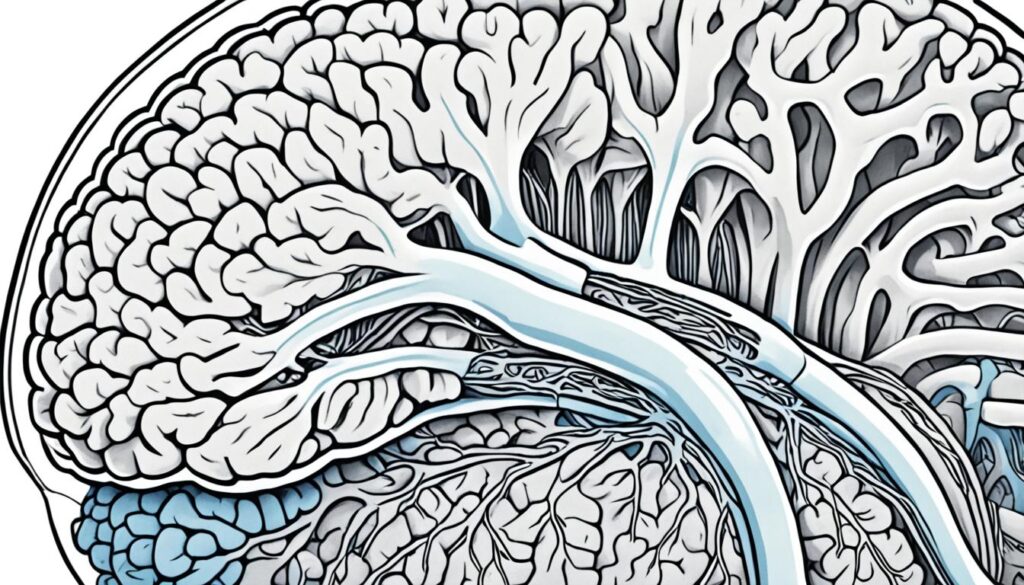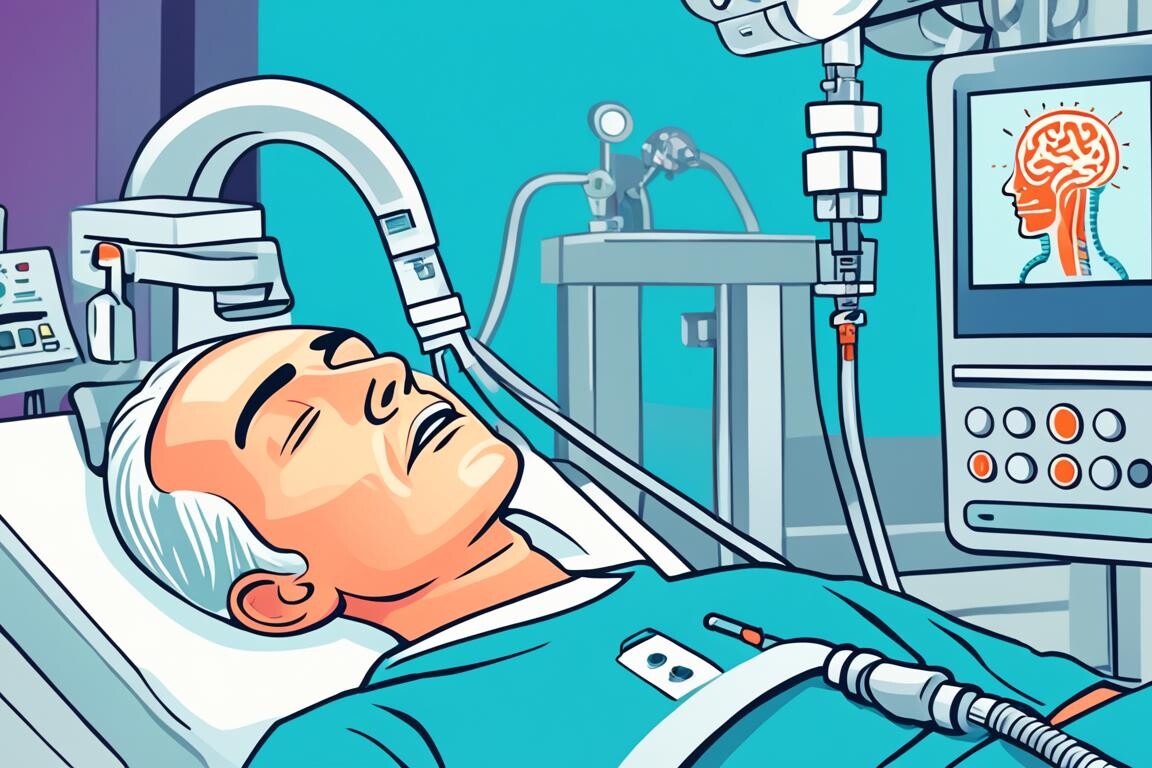Hydrocephalus is a brain disorder. It happens when too much fluid builds up in the brain. This fluid, called cerebrospinal fluid, makes the brain’s spaces expand. This puts pressure on the brain and can damage it. This issue can be there from birth or develop later due to injuries. It can happen to people of any age, but it’s more common in babies and adults over 60.
Knowing about hydrocephalus and its causes is very important. If it’s not treated, it can cause serious symptoms and problems. But, with the right care, many people can live well with hydrocephalus. Later on, we’ll talk more about this condition and its different aspects.
Table of Contents
ToggleWhat is Hydrocephalus?
Hydrocephalus is the buildup of fluid in the brain’s ventricles. It makes the ventricles bigger, putting pressure on the brain. This happens when cerebrospinal fluid doesn’t flow right, damaging brain tissues.
It can happen at any age, but it’s more common in infants and adults over 60.
Definition and Causes
Your brain floats in a bath of cerebrospinal fluid. This fluid also fills large structures deep in your brain called ventricles. It helps the brain stay buoyant and protected. When there’s too much fluid, hydrocephalus occurs. This happens when there’s an issue with fluid production and absorption.
Brain Ventricles and Cerebrospinal Fluid
Your brain sits in cerebrospinal fluid. It’s in ventricles deep within the brain. These ventricles keep the brain afloat and protected. Hydrocephalus arises when there’s a hiccup with fluid production and absorption.
Types of Hydrocephalus
There are different types of hydrocephalus. These include communicating and non-communicating hydrocephalus. There’s also normal pressure hydrocephalus, more common in the elderly. Another type is hydrocephalus ex-vacuo, which happens when brain tissue shrinks from damage or disease.

Symptoms of Hydrocephalus
Infants
Infants with Hydrocephalus Symptoms. These include a bigger head size than usual and a quickly growing head. A bulge or tense soft spot on the head could be present.
They might also seem sleepy, be irritable, or not eat well. Other signs can be vomiting, seizures, and eyes looking downward. Babies might have issues with their muscle strength and tone.
Children and Adolescents
Hydrocephalus signs in older kids or teens can vary. Headaches, vision problems, and odd eye movements might happen. The head could also enlarge; they could feel tired or get sick.
They might have issues balancing or coordinating. Appetite might be low, and they could lose control of their bladder. This could lead to crankiness, personality changes, or in school.
Adults
For young to middle-aged adults, symptoms might include headaches or feeling sluggish. They could also lose their balance or speak, have vision issues, or notice memory decline.
Older adults might experience worse memory loss or find it hard to think. Walking, coordination, and balancing could also become difficult. Bladder control problems, particularly for both age groups, can be signs too.
Risk Factors and Complications
Newborns
Hydrocephalus might be there when a baby is born, called congenital hydrocephalus. It’s from the brain growing in a way that stops fluid from flowing right. Also, bleeding or an infection when in the womb can cause it.
Other Contributing Factors
Tumors in the brain or spine, infections in the central nervous system, and brain bleeding from events like strokes can lead to hydrocephalus. So can serious head injuries.
Potential Complications
Untreated hydrocephalus can get worse and cause problems like learning and physical issues. It might even lead to death. But, with early treatment, serious problems can be less.
What is Hydrocephalus? Understanding the Condition
Hydrocephalus is a brain condition. It’s when too much fluid builds up in the head’s ventricles. This pressurizes the brain’s tissues. The excess fluid makes the ventricles widen.
It can affect anyone, but it’s most common in infants and those 60 or older. The added pressure on the brain can be serious. If not treated, it causes problems with how the brain works.

This issue can happen for different reasons. It might be there when a baby is born. Or it could develop later due to things like tumors, infections, or injuries. People of all ages can get it, but certain groups are at higher risk.
It’s vital to know the warning signs of hydrocephalus for fast help. Babies might have a bigger head, be sick a lot, or seem tired and weak. Older kids and teens could get headaches or have trouble seeing or moving. They might also act differently than before.
Adults can struggle with their memory, walking, or handling their bladder. Quick treatment is key to dealing with hydrocephalus. It can stop serious problems from happening. Many with hydrocephalus live fulfilling lives with the right care.
Diagnosis and Testing
Finding out if you have hydrocephalus is the first step in treating it. Your doctor will start by talking with you and checking your health history. Then, they will do a full exam to look at your brain’s health.
Imaging Tests
Your doctor might also want images of your brain to diagnose hydrocephalus. They could order an ultrasound, CT scan, or an MRI scan. These tests show if you have too much fluid in the ventricles of your brain. They can check for anything blocking the fluid too.
Other Diagnostic Procedures
If needed, there are more tests. You might have a spinal tap to check liquid pressure. Or, they could use a tiny pressure sensor in your head to monitor the pressure. These tests give your team more information to plan the best care for you.
Treatment Options
Have you or a loved one been diagnosed with hydrocephalus? There are several treatment options. These are to help manage the condition and its symptoms. Shunt surgery is the most common. Another option is endoscopic third ventriculostomy (ETV). After any surgery, it’s vital to have ongoing monitoring and possibly rehabilitation for your health and wellbeing.
Shunt Surgery
Shunt surgery is the top choice for hydrocephalus treatment. A flexible tube called a shunt drains extra cerebrospinal fluid (CSF) from the brain. It moves it to another part of the body where it’s absorbed. The shunt has a valve to manage the CSF flow, which eases brain pressure. This surgery takes 1-2 hours and might need a few days in the hospital to recover.
Endoscopic Third Ventriculostomy
Another choice is endoscopic third ventriculostomy (ETV). ETV uses a tiny camera to make a new path for CSF to flow. This action lowers the pressure. It’s done under general anesthesia in about an hour. ETV usually has less infection risk than shunt surgery. However, there could be blockage risks over time.
Follow-up and Monitoring
Regular check-ups and monitoring are crucial after hydrocephalus surgery. Your healthcare team will test your brain function. They will also see if you need more rehab or support. It’s key to report any troubling symptoms quickly. Shunts may need fixing or can block, needing more surgery to fix.
Conclusion
Hydrocephalus is a serious condition that affects the brain. It needs quick diagnosis and treatment. This stops big problems from happening. It happens when fluid builds up in the brain, mostly in babies and older people.
Doctors often use shunt surgery to treat it. This surgery helps manage the problem. It is important to keep an eye on the condition over time.
Visiting your doctor regularly is key. They can help you know how to live well with hydrocephalus. By learning about it, you can be a big part of your care.
For more on hydrocephalus, check out this guide from the University of New Mexico. With the right help, many people with hydrocephalus lead full lives.
FAQ
What is hydrocephalus?
Hydrocephalus is a disorder from too much fluid in the brain. This fluid buildup can squash the brain’s tissues by widening spaces that hold it.
What causes hydrocephalus?
An overflow of cerebrospinal fluid causes hydrocephalus. This happens when the body makes too much fluid or can’t clear it well. It’s seen from infancy through old age, but most often in babies and seniors.
What are the symptoms of hydrocephalus?
The signs change with age. Babies may show a fast head growth, be sick a lot, and seem fussy. They might also have weak muscles. Older folks might get headaches, trouble with their eyes, or it’s harder to think straight. They could also have a hard time walking and controlling when they pee.
How is hydrocephalus diagnosed?
Doctors start with a close look at symptoms, your past health, and how you look and move. Tests, like CT scans and MRIs, show the problem. Things like spinal taps or watching brain pressure might also happen.
How is hydrocephalus treated?
Shunt surgery is the go-to fix for hydrocephalus. A tiny tube lets fluid leave the brain to be soaked up elsewhere. Another choice is a surgery that makes an opening to let fluid out. After either, patients face rehab and regular check-ups.
Source Links
- https://www.mayoclinic.org/diseases-conditions/hydrocephalus/symptoms-causes/syc-20373604
- https://www.aans.org/en/Patients/Neurosurgical-Conditions-and-Treatments/Hydrocephalus
- https://www.ninds.nih.gov/health-information/disorders/hydrocephalus
- https://www.mayoclinic.org/diseases-conditions/hydrocephalus/diagnosis-treatment/drc-20373609
- https://www.nhs.uk/conditions/hydrocephalus/treatment/
- https://coc.unm.edu/common/manual/hydrocephalus.pdf
About The Author

This article is medically reviewed by Dr. Chandril Chugh, Board-Certified Neurologist, providing expert insights and reliable health information.
Dr. Chandril Chugh is a U.S.-trained neurologist with over a decade of experience. Known for his compassionate care, he specializes in treating neurological conditions such as migraines, epilepsy, and Parkinson’s disease. Dr. Chugh is highly regarded for his patient-centered approach and dedication to providing personalized care.
→ Book a consultation to discover which remedies suit your needs best.




